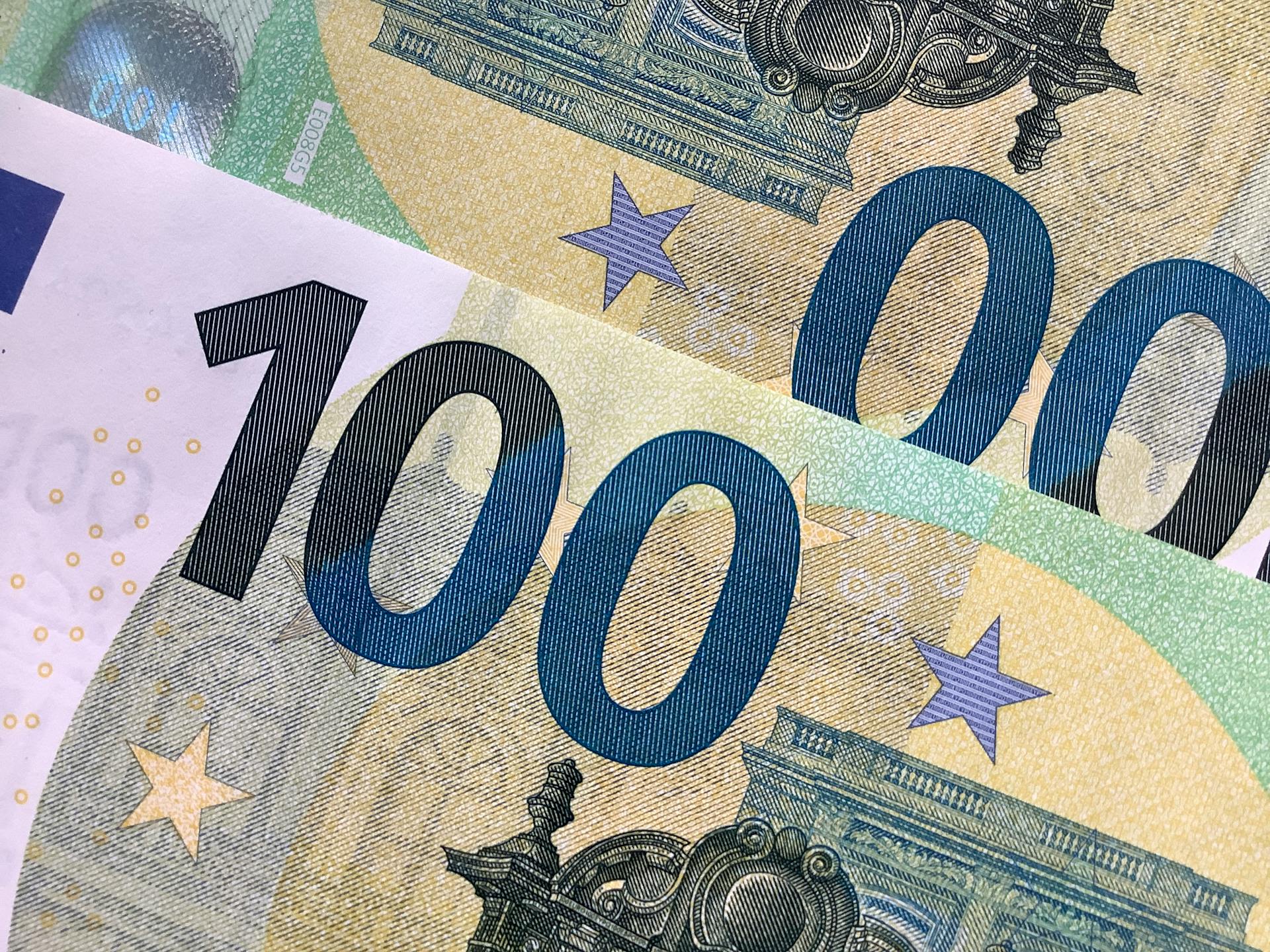
The Maastricht Criteria were established to ensure economic stability within the European Union. These criteria were agreed upon in 1992.
The criteria include four key areas: inflation, interest rates, budget deficits, and exchange rates. The idea behind these criteria is to create a stable economic environment for all member states.
To meet the inflation criterion, a country's inflation rate must not exceed 1.5 percentage points above the average inflation rate of the three best-performing member states. This ensures that no single country's inflation rate gets too far out of line with the rest of the EU.
The interest rate criterion requires that a country's long-term interest rate must not exceed 2 percentage points above the average long-term interest rate of the three best-performing member states. This helps to keep borrowing costs in check and promotes economic stability.
For your interest: European Exchange Rate Mechanism
What Is the Treaty?
The Maastricht Treaty was signed on February 7, 1992, in the Dutch city of Maastricht. It created the European Union (EU) and became effective on November 1, 1993.

The treaty was signed by representatives of 12 member nations that made up the European Community (EC). These countries included Belgium, Denmark, France, Germany, Greece, Ireland, Italy, Luxembourg, Netherlands, Portugal, Spain, and the United Kingdom and Northern Ireland.
The treaty established a common European citizenship, allowing residents to move, live, and work freely between member states. This was a significant step towards greater cooperation and unity among the member nations.
The Maastricht Treaty also created a shared economic, foreign policy, and security policy system among the member states. This included cooperation on security and legal affairs.
The treaty established a timeline for the creation and implementation of the European Economic and Monetary Union (EMU). The EMU was to include a common economic and monetary union, a central banking system, and a common currency.
The European Central Bank (ECB) was established in 1998, once the end of the year conversion rates between member states' currencies was fixed. This was a prelude to the creation of the euro, which began circulation in 2002.
The treaty introduced the criteria that countries must meet if they want to join the euro. These criteria include being stable in inflation, levels of public debt, interest rates, and exchange rates.
Recommended read: European Monetary System
Key Provisions

The Maastricht criteria have four key provisions that member states must meet to progress towards the adoption of the Euro.
The first provision is that inflation must be kept at a rate no more than 1.5 percentage points higher than the average of the three best performing member states.
Member states must also maintain a budgetary position that avoids excessive government deficits, defined as ratios to gross domestic product (GDP) of greater than 3% for annual deficits and 60% for gross government debt.
The exchange rate of the national currency must be within the normal fluctuation margins by the exchange-rate mechanism of the European Monetary System without severe tensions for at least the last two years.
Nominal long-term interest rates must be no more than 2 percentage points higher than in the three member states with the lowest inflation.
Economic Union
The Maastricht economic-policy model aimed to maintain price and financial market stability through restrictive control of monetary growth and public expenditure.
Critics argued that this approach was a form of "reversed Keynesianism", where macro-economic policy focused on stability rather than securing a full-employment level of demand.
This approach denied member states the ability to use currency deflation to ease balance-of-payments constraints on domestic spending, leaving labour market "flexibility" as the main means of coping with economic shocks.
In the European debt crisis, several Euro-zone countries (Greece, Portugal, Ireland, Spain, and Cyprus) were unable to repay or refinance their government debt without assistance from third parties, leading to calls for new arrangements to manage payment imbalances between member states.
The austerity measures imposed as a condition of assistance from Germany and other EU partners raised concerns about the burden of adjustment on wage- and benefit-dependent households.
German finance minister Wolfgang Schäuble defended the Maastricht criteria, arguing that there is a "moral hazard" in allowing member states to accumulate higher debts within the Eurozone, which ultimately have no relationship to higher growth.
The Maastricht criteria placed the onus for growth on "competitiveness, structural reforms, investment, and sustainable financing", which some argued was the right approach to stimulate growth.
European Monetary System

The European Monetary System was a precursor to the single currency. It was established in 1979 to promote economic convergence among member states.
The EMS was a network of exchange rate agreements between European countries that allowed for limited exchange rate fluctuations. This was a key step towards a single currency.
The EMS was designed to stabilize exchange rates and promote economic cooperation among member states. It was a crucial step towards the creation of a single European currency.
The EMS was replaced by the European Union's Economic and Monetary Union (EMU) in 1999. The EMU introduced a single currency, the euro.
The EMS was a significant step towards European economic integration.
EU Expansion and Reforms
The European Union's expansion and reforms are crucial to its growth and stability. The Maastricht criteria played a significant role in these efforts.
The Maastricht Treaty, signed in 1992, established the EU's single currency, the euro, and laid the groundwork for further integration. This treaty also created the European Central Bank, which oversees monetary policy for the eurozone.
The EU has since expanded to include 27 member states, with several more countries in the process of accession. The union has also implemented various reforms to strengthen its institutions and decision-making processes.
Enlargement and Post-Reforms

The EU's Enlargement and Post-Reforms period saw significant changes to the union's structure and membership. The European Union's Enlargement Strategy was introduced in 2006 to guide the accession process for new member states.
The strategy focused on the EU's immediate neighbors, with the aim of bringing them into the fold. The Western Balkans, in particular, were a key priority.
In 2013, Croatia became the 28th member state of the EU, marking a major milestone in the Enlargement process. The country's accession negotiations began in 2009 and took four years to complete.
The EU's Enlargement and Post-Reforms also involved the establishment of the European Neighborhood Policy (ENP) in 2004. The ENP aimed to strengthen ties with neighboring countries and promote their integration into the EU.
Amending Treaties
Amending Treaties is a crucial process in the European Union's (EU) evolution. The Maastricht Treaty amended the treaties that established the European Communities in the 1950s.
The EU has undergone significant expansions, with Austria, Finland, and Sweden joining in 1995. The treaties of Amsterdam (1997) and Nice (2001) were then amended to accommodate these new member states.
In 2004, ten countries from the former Eastern Bloc - Bulgaria, the Czech Republic, Estonia, Hungary, Latvia, Lithuania, Poland, Romania, Slovakia, and Slovenia - plus Cyprus and Malta joined the EU. This led to a comprehensive review of the Treaty on European Union and the Treaty Establishing the European Community (TEC).
The 2007 Treaty of Lisbon amends both the Treaty on European Union and the Treaty Establishing the European Community, renaming the latter as the Treaty on the Functioning of the European Union (TFEU).
EU Citizenship
EU Citizenship is a fundamental aspect of the European Union, established through the Treaty. Every person holding the nationality of a Member State shall be a citizen of the Union.
The free movement of workers was a key consideration in the establishment of the European Economic Community in 1957, with the idea that it was the logical corollary of the free movement of capital, goods, and services. This led to the creation of a common and parallel citizenship.
Member State migrants have the right to take up residence and employment in other EU countries, and for the first time, they also have the right to vote and stand in both local and European elections in their new country of residence.
Foreign, Security, Justice and Home Affairs
The European Union's foreign and security policy, as well as justice and home affairs, were considered the second and third "pillars" of the Union alongside the European Community.
The Maastricht Treaty proposed no significant departures in these areas, instead building on existing cooperation frameworks. European Political Cooperation (EPC) had been in place since the 1970s, and the Schengen Agreement and Convention were already being used to coordinate law enforcement and judicial matters.
Governments were simply asked to "inform and consult one another within the Council of Ministers" without significant changes to their roles. The West European Union was seen as an integral part of the Union's development, but Member States were free to make their own foreign and defence policy decisions.
A Council decision was required to take collective action, and even then, unanimity was needed, giving Member States significant flexibility. This was a concession to the United Kingdom, which continued to prioritize the North Atlantic alliance.
For more insights, see: Foreign Exchange Rate Management
Subsidiarity and Co-Decision
The Maastricht Treaty introduced subsidiarity as an explicit constitutional principle, but this has led to debates about whether it strengthens states, regions, or local government vis-à-vis the EU or vice versa.
Subsidiarity can be read as a federalising principle, elevating simple utility above any deference to national or local feeling, with a presumption that action will be taken at European level only where national efforts cannot achieve the objective in question.
The Treaty offers no legally actionable definition of subsidiarity, instead providing a series of tentative indications for Community action in a document full of imprecise concepts.
The 1992 Treaty also introduced co-decision, making the European Parliament a co-legislator with the Council of Ministers.
Co-decision procedures have been developed and extended to nearly all areas where the Council decides on legislation by qualified majority voting.
Formal and informal reconciliation procedures have been established, including a conciliation procedure and trialogues involving negotiations between the European Parliament, Council, and Commission.
These procedures have become standard in most legislative procedures, allowing for a more collaborative approach to decision-making.
Ratification and Implementation
The Maastricht Treaty was ratified by the High Contracting Parties in accordance with their respective constitutional requirements.
In Denmark, a second referendum was held after concessions were secured, and the treaty was endorsed by a vote of 56.7% on May 18, 1993.
The treaty was also ratified in Ireland, where the Eleventh Amendment of the Constitution was approved in a referendum held on June 18, 1992, with 69.1% of votes cast in support.
In France, a referendum in September 1992 narrowly supported the ratification of the treaty, with 50.8% in favour.
Germany was the last member state to ratify the treaty, which passed the Bundestag on December 2, 1992, with a majority of 543 out of 562.
The ratification of the Maastricht Treaty in the United Kingdom did not command a clear majority, with Prime Minister John Major facing down his "Maastricht Rebels" by tying ratification to the survival of the government in a vote of confidence.
The German Federal Constitutional Court delivered its judgment on October 12, 1993, ruling the Maastricht Treaty compatible with the Grundgesetz, but provided that the European Union could not endow itself with more powers without the Bundestag’s approval.
Frequently Asked Questions
What is the criteria for the Maastricht deficit?
The Maastricht criteria for the general government sector specify a maximum government deficit of 3% of a country's GDP. This is a key benchmark for EU Member States to maintain fiscal stability.
What is the Maastricht standard?
The Maastricht standard refers to the economic criteria that EU member states must meet to join the euro zone. These criteria include indicators such as inflation, interest rates, and government debt, which ensure economic stability and convergence among member states.
Which are the 5 convergence criteria the Maastricht criteria to be fulfil in order to join the Euro zone?
To join the Euro zone, a country must meet five key convergence criteria: price stability, sound public finances, exchange-rate stability, long-term interest rates, and not exceeding the excessive deficit procedure. These criteria ensure a country's economic stability and readiness to adopt the Euro.
Sources
Featured Images: pexels.com


